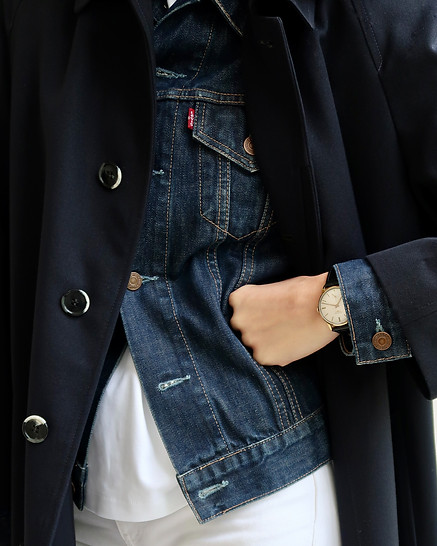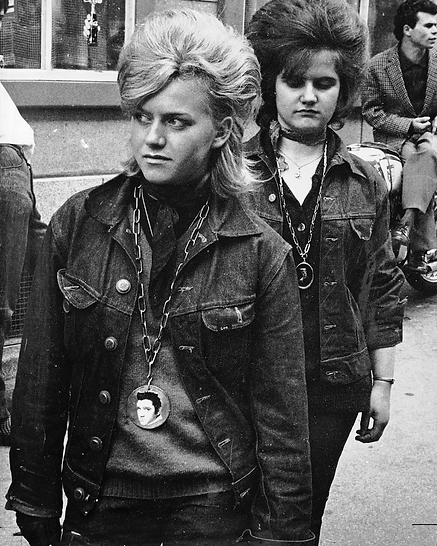DENIM JACKET CULTURE
19 May 2022

Levi's denim jacket / Type III
Some ten years after his enormous creative success in the 1860s, when he established the culture of wearing jeans among miners, cowboys, and railroad workers, Levi Strauss continued to design new pieces of denim clothing. He realised that the workers needed a garment for their upper body in addition to their daily jeans uniform. The result was a denim jacket, another in a line of garments that were initially exclusively worn for work but have, thanks to its functional and utilitarian design been worn outside the contexts for which they were initially intended. Indeed, the denim jacket embodies the history of American style and represents a variety of subcultures: it was worn by hippies, rockers, rappers, cowboys, and other supporters of seemingly incompatible styles, respectively. The denim jacket did stand for a culture of evolution, independence, and–above all–freedom.


An old Levi's ad from the beginning of 20th century
Cowboys via levi.com
"Our denim jacket was very durable for all kinds of manual labour. To allow the wearer more room, the horizontal seams supporting the pleats could be removed," explains Tracey Panek, a historian of Levi Strauss & Co. The Levi's blouse, which Strauss first made in 1905, served as the inspiration for the Trucker jacket, also known as the “denim jacket”. He designed the first denim top, known as the Type I. It was a denim jacket that had just one front pocket and was made of dark denim. The red label, which we still identify as Levi's apparel today, wasn't introduced until 1936. The jacket also included silver rivets instead of bronze ones added in later iterations. As a result, the Type I was referred to as a denim blouse until 1938 when the Dude Ranch catalogue made the first reference to this item as a–jacket.
A decade later, Levi's introduced a new jacket shape, the Type II. It was the 1950s when a generation of young people first began to embrace denim, turning it from workwear into a well-known uniform of rebellion. This second variation of the denim jacket differed from the first in length, a double pocket was added on the chest (reinforced with clips instead of rivets), and a buckle was placed on the back to adjust the waist. Despite Type II being a favourite among young rebels and workers, production was short-lived. Namely, Levi’s already stopped production in 1962–nine years after the creation of the new jacket–which, however, only contributed to its cult status. Admittedly, the company wasted no time, considering that Type III was introduced the same year based on sketches by designer Jack Lucifer. Lucifer removed the details of the former jacket, such as pleats and rivets, and created a slimmer silhouette by creating two V seams that go over the pockets and towards the hem. The pockets on the new jacket sat higher on the chest, were smaller and had a pointed flap. Such a new form of the jacket fit perfectly into the narrow-cut fashion landscape of the time, but this third variation of the jacket is still worn today.

Type I, the first Levi's jacket model, 1900s

Type II, the second model of the Levi's jacket, from 1953

Type III, the third model of the Levi's jacket, from 1962
Clothing is always a vital signifier of youth culture. It stands for political affiliation, sexual orientation, and class; through it, young people show where they are and where they want to be. Such visual coding is indeed present in the denim jacket and has been embraced by numerous subcultures. But how did the denim jacket, as a former symbol of conformity and traditional values, become a part of youth culture, a symbol of rebellion, anarchy and counterculture?
In British youth culture, the denim jacket appeared shortly after the end of the Second World War, when it was frequently worn by teenagers, young men, and women eager to escape the dark shadow of war that loomed over them. At the same time, across the ocean, where the jacket originated, denim became the favourite clothing material of American rebels. Panek, the historian of Levi's company, states that until the fifties of the last century, wearing denim was often associated with juvenile delinquency, which, among other things, led to the banning of wearing denim in some schools. Jeans and a denim jacket thus became the uniforms of non-conformists, concludes Panek.

Youth in denim jacket via Pinterest

Madonna in the 80s, via Pinterest

Girls of the 60s via Pinterest

John Lennon, another denim admirer, via Pinterest
The hippie and counterculture movements of the 1960s also enjoyed wearing denim jackets, thrown over t-shirts with political slogans or combined with brightly coloured psychedelic designs that reflected the hopes and new outlooks of the times (or worn on the bare body, with the sleeves cut off to see the tattoos on the shoulders). Thus, the denim jacket came to represent the rejection of all inequality: class, race, gender, or sexuality. At the same time, the denim jacket became one of the first unisex garments.
Along with the rebel culture of the denim jacket, it is also associated with pop culture. James Dean and Steve McQueen were its more famous wearers. Marlon Brando wears it in the 1953 film “Rebel Without A Cause,” whose title song was sung by Elvis Presley, also wearing a tight-fitting dark denim jacket. Young people then flocked to buy similar jackets in order not to acquire the unusual lousy boy look that, of course, Levi's company produced in response to the demand created by the film. They were also worn by musicians of the rock and punk genre, where band T-shirts and jeans with rivets became a visual representation of anti-establishment rock band anthems. The messages remained the same in later decades, but the genres expanded. The denim jacket became popular among hip-hop musicians in the 1990s and 2000s. With such a wealth of differences, the denim jacket once again confirms the power of the message that one garment can convey.

Steve McQueen via Pinterest

Elvis Presley via Pinterest
Indeed, today, practically every major clothing company that produces variations of this classic garment attests to the simplicity and adaptability of the denim jacket design. Levi's has managed to deliver one of its core products and maintain its relevance to this day despite rebuilding the silhouette or replacing the fabric, proving the widely held belief that quality and timeless design transcend any time context of fashion.